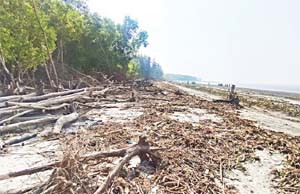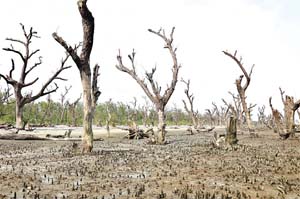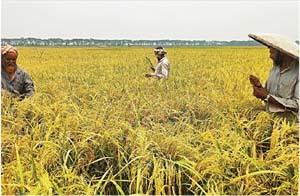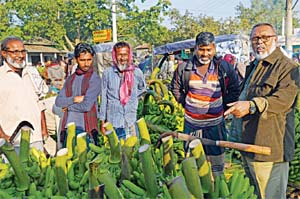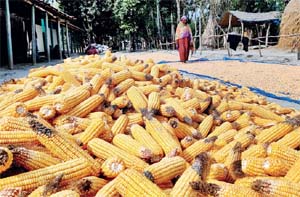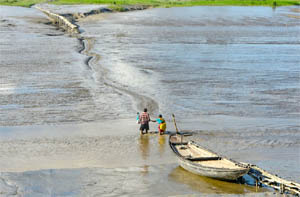The post Frequent cyclones hit agriculture hard in coastal Bangladesh appeared first on Dhaka Mirror.
]]>Emran Hossain
With another cyclonic storm brewing in the Bay of Bengal, the third one in a little over a month, farmers on Bangladesh’s coast are busy harvesting their partially ripened crops, potentially losing their expected production significantly.
The Department of Agricultural Extension completed its assessment of agricultural losses from the last cyclonic storm, Midhili, which made landfall on November 17 along the southern coast, affecting 292,419 farmers in 16 coastal districts.
While the DAE estimated the crop loss to be worth more than Tk 387 crore, vast stretches of crop fields lay submerged in water until Tuesday in the coastal region, providing a gleaming example of how destructive even a small cyclonic storm could be for poor farmers.
The cyclonic storm Midhili was dubbed an insignificant cyclonic storm that moved onto land just hours after it was born.
The crops in many coastal fields, mostly aman paddy, the second most important rice crop, are not ripe and ready to be harvested, leaving many farmers in a precarious situation.
‘The problem is that 70 per cent aman is not ready to be reaped yet,’ Showkat Osman, the chief of the Barishal regional office of the DAE, told New Age.
Aman was grown on more than 700,000 hectares of land in the Barishal region, he said.
Agricultural extension officers in the coastal region have been advising people over the past four to five days, often sending teams with loudspeakers, to harvest their crops as soon as possible with a cyclonic storm likely by December 2.
Barishal, Bhola, Patuakhali, and Barguna emerged as the worst-affected areas in the cyclonic storm Midhili, accounting for more than 60 per cent of agricultural losses estimated by the DAE in 16 coastal districts.
A total of 21 crops were cultivated on 16.26 lakh hectares in the affected coastal region, with the Midhili affecting 243,294 lakh hectares, more or less, according to the DAE.
Five per cent of aman paddy fields were affected by Midhili, affecting 163,449 farmers, according to the DAE.
The crops that were mostly affected are maize, vegetables, mustard, soybean, lentil such as grass pea, onion, and chilli, according to the DAE data.
The DAE estimate of disaster losses usually underestimates the actual loss to show the low demand for helping farmers.
Farmers are not insured, and the help the government provides to them is minimal.
‘The affected farmers will be prioritised in the future distribution of subsidised seeds,’ said Badal Chandra Biswas, director general, DAE.
The supply of subsidised seeds and fertilisers amidst frequent natural disasters helps farmers very little, particularly because of their wretched conditions with many cultivating crops with high-interest loans.
Coastal farmers could have taken home an increased aman harvest had they been able to plant the crop in time, the DAE officials said.
The deadline for planting aman in the coastal region is the second week of September, which could not be followed this year because of water stagnation from unusually heavy rain in August.
Many farmers in Barishal, Barguna, Bhola, and Patuakhali planted aman on September 28, still in fields sunk in knee-deep water, according to local DAE offices.
Coastal farmers are not alone in touch time. In the northern region, farmers had to put up with waves of flash floods during the cultivation of boro, the main rice crop.
The area over which the potential cyclone is getting into shape has a reputation for developing strong cyclones, often taking the direction of hitting the southern Bangladesh coast, independent forecasters said.
On Tuesday, the India Meteorological Department warned that the low-pressure area over the South Andaman Sea kept intensifying and was likely to turn into a cyclonic storm by December 2.
Besides causing agricultural losses, cyclone Midhili killed at least 10 people.
Cyclone Hamoon, which hit on October 24, affected 50,000 farmers in Cox’s Bazar district.
– Article originally appeared on New Age.
The post Frequent cyclones hit agriculture hard in coastal Bangladesh appeared first on Dhaka Mirror.
]]>The post Week-long tree fair ends appeared first on Dhaka Mirror.
]]>A week-long tree fair and plantation drive, held on Moulvibazar Government High School grounds, concludes today.
The fair, organised by Moulvibazar district administration and the Department of Wildlife Management and Nature Conservation, began on July 27.
Students, among other visitors, got the chance to explore an array of varieties, both local and foreign, that were on display in different stalls at the fair.
Fruit trees got the most attention, as many were seen for the first time by spectators.
“I did not know the names of many fruits displayed here,” said Satyabrata Sen Gaurab, a fourth grader at Moulvibazar Govt High School.
“I have never seen a Brunei King mango until now… such a big mango,” said Habiba Akhtar Arifa, an eighth grader.
“We brought about 250 varieties of fruits and flowers to the fair, including persimmon, avocado, cherry, palm, and Brunei King mango, as the demand for such exotic varieties is usually high,” said Abul Kalam, owner of Kalam Nursery.
The post Week-long tree fair ends appeared first on Dhaka Mirror.
]]>The post Trees on 50 acres lost in 5yrs appeared first on Dhaka Mirror.
]]>The Shuvo Sandhya Beach in Barguna’s Taltali upazila has been facing serious erosion by the Bay for the last couple of years.
Due to continuous erosion by the Bay, nearly 50 acres of forestland close to the beach and about 60,000 trees have already been washed away in the last five year.
Meanwhile, due to destruction of the natural beauty of the beach, the number of tourists has decreased significantly in the recent years.
Shuvo Sandhya Beach was built on the shores of the Bay of Bengal in southwest of Taltali upazila headquarters in 2010. Later, forest department planted over one lakh trees of different species, including Jhau, on 125 acres of land in an attempt to protect the nearly 6-kilometre-long beach from being washed away by the tidal surges.
But due to tidal surges caused by the rough waves of the sea, the beach area as well as vast forestland are gradually decreasing every year.
Since 2018, at least 60,000 trees on nearly 50 acres of forestland on the beach area have either been washed away or died due to continuous erosion by the Bay.
Moreover, Local Government Engineering Department (LGED) built a brick road, which connects the beach, to facilitate tourists’ movement, but a major portion of the road has already been lost to the sea.
During a recent visit to the beach area this correspondent saw hundreds of dead trees are lying scattered across the beach.
Abu Hena Mostafa, a student at Patuakhali Science and Technology University, said there were many types of trees, especially a beautiful Jhau garden, when he first came here in 2015.
But, due to continuous erosion by the Bay the beach has lost its attraction now, he added.
Moniruzzaman, Range Officer at Taltali Forest Department, said afforestation was started by planting 12,000 Jhau trees in 2013-14 fiscal year.
Later, large gardens were developed by planting various mangrove species of trees along the beach in to prevent soil erosion.
But the erosion has washed away at least 60,000 trees in the last five years. He said they have a plan to plant 50,000 more trees on the beach.
– Article originally appeared on The Daily Star.
The post Trees on 50 acres lost in 5yrs appeared first on Dhaka Mirror.
]]>The post Kuakata Beach: 75,000 trees lost to erosion every year appeared first on Dhaka Mirror.
]]>There was a time when coconut, palm, tamarisk, and mangrove trees swayed with the winds on Kuakata Beach. Their tall trunks guarded the shore-dwellers against the wrath of natural calamities.
However, the current state of the National Park, a government-declared forest reserve along this coastal belt since 2005, only brings dismay to tourists and locals.
About 2,000 hectares of forest land on the 18-km beach have been washed away in the last 13 years. The coconut orchards have completely disappeared, while only one-third of the tamarisk and palm trees continue to breathe in the reserves.
Most of these trees have fallen prey to erosion, a common phenomenon by the Bay, alarmingly increasing risks for the locals of this disaster-prone area.
According to Patuakhali forest department sources, to make Kuakata more attractive to tourists, the department created a tamarisk garden adjacent to the beach in the financial year 2007–08. The garden stretches across 10,000 hectares of land along the shoreline.
Since 2010, 2,166 acres of fresh land have been turned into reserves.
In 2019, another 60 hectares were converted into tamarisk gardens, while acacia were planted on another 25 hectares along the shore in Gangamati area.
The following year, 85 more hectares were converted into reserves, planting different species of plants suitable for the region.
Meanwhile, erosion and tidal surges annually obliterate at least 50 hectares of forest reserves. In the last five years, such disasters have claimed approximately 250 hectares of the reserves as the aforementioned calamities frequently hit the shore during the stipulated period, informed Mahipur range officials.
Over 100 acres of forestland are washed away every year, uprooting nearly 75,000 trees of different species, especially Kewra, according to forest department sources.
The panoramic beach, once running 18 kilometres, has shrunk significantly due to continuous erosion, making it difficult for tourists to enjoy walks during high-tides. The beach and the forest will disappear if immediate steps are not taken to address this issue, said Asaduzzaman Miraj, a local.
“Deploying geo bags and blocks can help prevent erosion. The risks can be further reduced by planting more trees, as they would guard the shores naturally,” he added.
Visiting the Gangamati forest reserves and the beach recently, this correspondent witnessed a heart-wrenching scenario.
Thousands of uprooted trees, particularly Kewra plants, were left stranded across a two-km stretch from the beach all the way to the reserves, making it difficult for tourists to navigate.
“About a decade ago, the beach was surrounded by mangrove trees, half of which seem to have disappeared now,” said Mezbah Uddin, member secretary of Bangladesh Paribesh Andolan’s Kalapara regional branch.
While the accumulated saltwater left behind by the tidal surges causes the mangroves to die as they cannot breathe, illegal encroachments for the construction of brick kilns, unplanned soil excavation for embankments, and fish enclosures further plague the reserves, he added.
Vast forest tracts in Kuakata zero-point, Kawar Char, Gangamoti, Jatiya Udyan, Lembur Char, and Khajura are being lost to erosion, informed Shofiqul Islam, forest officer of the division.
The same number of trees that are lost each year are being planted as part of regeneration and planting initiatives, he said.
The forest department has initiated a project named Biodiversity Conservation and Eco-tourism Development in collaboration with the Water Development Board and Jica to safeguard the reserves, he added.
– Article originally appeared on The Daily Star.
The post Kuakata Beach: 75,000 trees lost to erosion every year appeared first on Dhaka Mirror.
]]>The post Bogura yoghurt, Chapainawabganj Langra and Ashwina receive the GI label appeared first on Dhaka Mirror.
]]>Four more products, including the yogurt of Bogura, and Langra and Ashwina varieties of mango of Chapainawabganj have been recognised as geographical indication (GI) products from Bangladesh.
In addition, the Aman variety of the fragrant Tulshimala rice from Sherpur has also acquired the GI tag, Md Zillur Rahman, deputy registrar (Trade Marks) of the Department of Patents, Designs and Trademarks (DPDT), said.
The department under the industries ministry issued GI certificates to the four products on 25 June.
With this, 15 Bangladeshi products, including Jamdani, Ilish, Muslin, Rajshahi silk, Rangpur’s Shatranji, Kataribhog rice of Dinajpur and Fazli mango of Rajshahi and Chapainawabganj, have been recognised as GI products so far.
Bogura, often dubbed as the capital of yogurt, produces an average of 50 tonnes of yogurt per day in around 400 factories of various sizes. Demand for the fermented dairy product doubles during festivals like Eid.
Nurul Bashar Chandan of Asia Sweets, a leading name for yogurt in Bogura at present that produces around 1,000kg of yogurt per day, sees the GI certification as a great opportunity to boost the yogurt market.
“With GI recognition, we will get multifarious benefits in terms of exporting yogurt. But if the yogurt is to be taken to the world market, the cooperation of the government is very much needed,” he said.
“The GI recognition has established a distinct identity for Bogura yogurt in the world,” said Hasan Ali, chairman of reputed sweets and yogurts manufacturer Akbaria Group.
“Bogura city and Sherpur Upazila together sell at least one lakh pieces of yogurt, worth Tk1 crore, per day. The country can generate more revenue by exporting the product,” he added.
The post Bogura yoghurt, Chapainawabganj Langra and Ashwina receive the GI label appeared first on Dhaka Mirror.
]]>The post BINA Dhan-25 shows hope appeared first on Dhaka Mirror.
]]>Sajjad Hossain
Mannan Joaddar cultivated BINA Dhan-25, a newly developed variety of paddy, on one bigha of land in Moghi village of Magura 93 days ago.
The 55-year-old farmer is now over the moon. He had not seen such thin and long grain in his 20 years of farming.
“I am hoping to get around 30 maunds of crop, which would be more than any other variety I have grown so far. It looks more like Basmati rice,” Mannan told The Daily Star yesterday.
In the last season, he grew BRRI Dhan-63 on the same land and had about 22 maunds of paddy. He spent Tk 10,000 to produce the paddy.
This time he is expecting to get more paddy spending the same amount of money.
“BRRI Dhan-63 has a life cycle of over 120 days whereas BINA Dhan-25 can be harvested in less than 100 days,” the farmer said.
Bangladesh Institute of Nuclear Agriculture (BINA) developed the new variety and supplied it to the farmers of 396 upazilas of 22 districts last year. This variety was developed from BRRI Dhan-29, officials said.
BINA officials recently visited two villages in Magura to see the yield.
Around 20 farmers in Moghi of Magura Sadar upazila and Bhaturia Danga of Mohammadpur upazila cultivated this variety.
Yasir Uddin, a farmer of Bhaturia Danga village, has also grown the variety on his 1.5 acres.
He is expecting to sell the paddy for Tk 1,400 to Tk 1,500 a maund. Last year, he sold BRRI Dhan-63 for Tk 1,200 to Tk 1,250 per maund.
“I’ve cooked the rice and it tasted good,” he said.
The new variety of paddy comes at a time when many millers cut and shape coarse rice into fine one using different methods. Nutrients such as zinc and iron are reduced in the process.
But BINA Dhan-25 needs not excessive processing as the rice is normally fine, said BINA officials.
Mirza Mofazzal Islam, director general of BINA, said any paddy usually contains 6.5 to 7.5 percent protein, but this has 9.1 percent protein.
“Due to its higher yield, dependence on imports could be reduced.”
The cost for producing this variety on one bigha, including fertilizer, water, pesticide, and seed, is Tk 10,000, he said.
Sakina Khanam, BINA’a principal scientific officer, who played a significant role in developing the BINA Dhan-25, said farmers could preserve its seed for a long time.
– Article originally appeared on The Daily Star.
The post BINA Dhan-25 shows hope appeared first on Dhaka Mirror.
]]>The post Banana cultivation shows bright prospect appeared first on Dhaka Mirror.
]]>Agriculture in Tangail region has changed a lot in the last three decades.
Once the land of this region was unfit for any cultivation. Back then, it wasn’t possible to grow crops due to uneven land surface and lack of irrigation facilities.
In the early 80s, the topography of Tangail’s Sakhipur, Ghatail, Basail and Madhupur upazila were almost the same.
But nowadays, a great variety of fruits has reached the region. Alongside pineapple, banana has now become a cash crop for many local farmers.
Different varieties of bananas like Sagar, Chinichampa, Shabri and Bangla Kabri are now being cultivated in different upazilas of the district.
Meanwhile, Kutubpur Banana Bazaar, located in Sakhipur upazila, has become a famous banana market for both the buyers and sellers in the region.
While visiting the banana market, one can see a different kind of busyness around the market area in the morning.
Farmers are seen bringing bananas on bicycles or rickshaw-vans while rows of bicycles, full of bunches of bananas, are parked at different spots.
One of the banana farmers said it costs Tk 180 to Tk 200 to produce a bunch of bananas. They sell each bunch of bananas to the wholesalers for Tk 400 and make a profit of Tk 200.
It has been calculated that about 500 banana trees can be planted in 35 decimals of land and growers can make a profit up to Tk 1 lakh from those trees.
Although banana cultivation started on a small scale in Tangail, Sakhipur has now become one of the major regions of banana farming due to proper irrigation facilities.
Farmers across the country follow various techniques as they have their own sustainable methods of ripening and marketing this fruit.
Banana farmers and traders at Kutubpur Banana Bazar said they grow bananas keeping people’s health in mind.
The good news is that many young entrepreneurs are also getting involved in banana farming nowadays.
I got the chance to go to Kutubpur Banana Bazar again after a long time.
Farmers said some of them sold the bananas directly from their orchard, while most of them sell their produces at Kutubpur Bazar.
Each bunch contains at least 100 to 120 bananas and local wholesalers pay Tk 400 to Tk 450 for each bunch.
On an average each banana costs Tk 3.5 to Tk 4, but the retail price of each banana is not less than Tk 8 to Tk 10.
Banana farmers in Tangail region are happy as proper irrigation facilities and a little guidance have taken them far way.
I was talking to some of the elderly farmers, who remembered the old days.
Once there was a cry for water in Tangail region.
Tangail Agricultural Development Project (TADP) has brought not only irrigation facilities but prosperity to the people of the area. This has been a blessing for the farming community in the region.
I believe, the kind of high-value crops that are now being produced in the hilly soil of Tangail is a model for other regions of the country.
I hope, as a predominantly fruit-growing area, local farmers will witness more prosperity in near future.
– Article originally appeared on The Daily Star.
The post Banana cultivation shows bright prospect appeared first on Dhaka Mirror.
]]>The post Maize farming leading char farmers to financial stability appeared first on Dhaka Mirror.
]]>About two decades ago, farmers in remote char areas of northern Bangladesh were quite impoverished due to the consequences of repeated flooding and other natural disasters.
Now though, these farmers have achieved financial stability by growing maize, which is more suitable for the region compared to other crops.
For example, more profitable crops such as jute and chili are easily damaged by heavy rain and pests but maize carries less risk in this regard while also providing ample returns, according to Nazir Uddin, a farmer of Kalur Para char under Saghata upazila of Gaibandha.
Mofiz Uddin, a farmer of Dighatkandi char in the same upazila, said a farmer can profit up to Tk 80,000 by cultivating one bigha of chili while growing maize on the same amount of land would earn him just over Tk 30,000.
But despite the considerably lower returns, growing maize bears little to no risk compared to chili while it only costs as much as Tk 9,000 to cultivate, he added.
Nurunnabi Mollah, a farmer of Deluabari char under Fulchari upazila, said cultivating jute is highly profitable but huge quantities of the crop are damaged by early floods each year.
“So, all things considered, we only get good profits from maize,” he added.
The financial condition of farmers in char areas was very poor until they started receiving stable profits from cultivating maize, which brought economic prosperity to the region,” said Nazir Uddin, who first started growing maize in the upazila’s char Jamira some 20 years back.
Jakirul Islam, a farmer of char Dakatmara under Bogura’s Sariakandi upazila, said he cultivated three bighas of maize at a cost of around Tk 24,000 this year.
“I harvested two bighas already and got around 70 maunds [one maund equals 37 kilogrammes],” added Islam, who made a profit of Tk 40,000 from the crop currently selling for about Tk 1,400 per maund.
Liton Mia, a farmer of char Tekani in the district’s Sonatal upazila, said he cultivates other crops with the profits earned from growing maize.
“You will surely profit by cultivating maize but other cash crops are risky,” he added.
Badar Uddin, a union parishad member of Fulchari upazila, said some 10,000 people live in Deluabari char, which was established around 40 years ago.
People in the area did not see much economic progress before cultivating maize but now, they are making quick progress.
“You will find that every char family now has a motorcycle, freezer, cattle and much more. The main is that maize cultivation has eradicated poverty in the region in many ways,” he added.
So, the expansion of maize grows ever quicker, especially in char areas, as the crop offers high profit for low investment.
In Gaibandha, farmers cultivated 17,200 hectares of maize, 11,000 hectares of which were in char areas. Similarly, 12,000 hectares in Bogura were brought under maize cultivation this year, according to the Department of Agricultural Extension (DAE).
Farmers in Bogura had cultivated 8,750 hectares of maize last year but this year, the acreage has increased to 12,000 hectares, said an official of the local DAE.
DAE officials expect maize yields in Bogura and Gaibandha will amount o nearly 3 lakh tonnes, which is estimated to be worth more than Tk 1,050 crore at the current market price.
According to the Bangladesh Wheat and Maize Research Institute, farmers in the country cultivated only 7 lakh tonnes of the crop in 2009 while it was 54 lakh tonnes in 2020.
Anamul Haque, additional deputy director of the DAE in Bogura said, maize cultivation is expanding in char areas for different reasons.
First, maize farming is increasing for the crops uses in different industries, such as bakery, poultry and fish farming businesses.
Second, maize imports have declined amid the ongoing Russia-Ukraine war and US dollar crisis.
Third, maize requires low investment and care but give bumper yields and profits.
And fourth, some private companies are importing high yield seeds that provide around 12 tonnes of maize per hectare.
“Therefore, maize is now the best cash crop for farmers in char areas,” Haque added.
– Article originally appeared of The Daily Star.
The post Maize farming leading char farmers to financial stability appeared first on Dhaka Mirror.
]]>The post Farmers find hope in solar-powered irrigation appeared first on Dhaka Mirror.
]]>Life is easier now for Abu Taleb, 45, a potato farmer of Saddyo Puskuruni village in Rangpur.
A year ago, high irrigation costs for diesel-run pumps, which he bore out-of-pocket, made it difficult for him to provide for his three children.
Now, after switching to solar-powered irrigation, his livelihood has changed for the better. “I can now afford new clothes and nutritious food for my family,” he said.
Like Abu Taleb, thousands of farmers in five northern districts are reaping benefits from the solar-powered irrigation system — five times cheaper than diesel-run pumps.
This happened after Barind Multipurpose Development Authority (BMDA), in Rangpur Division last year, introduced the new system with the aim of promoting environment-friendly approaches to agricultural production and boosting climate-resilience of farmers.
Under the project, 50 ring wells are supposed to be set up, at a cost of Tk 22 lakh each, in Rangpur, Gaibandha, Kurigram, Lalmonirhat and Nilphamari. So far, 34 wells have been put into operation while the rest are likely to be set up by the end of this year.
Another farmer, Yunus Ali from Botlagari Borodaha village in Nilphamari, said, “With solar-powered pumps, we pay only Tk 50 per hour for irrigation of one bigha of land whereas the cost was Tk 250 for diesel-run shallow pumps.”
Previously, Ali had to irrigate crops through multiple rounds, which meant the total cost was around Tk 2,000 for four months. Solar-powered pumps also require less rounds. “I irrigate three times per cycle now and pay around Tk 150,” said Ali.
Visiting several sites in the Rangpur district, this correspondent found that six to seven solar panels were installed on umbrella-shaped metal structures above deep ring wells.
“Rainwater, or surface-level water, stored in these deep ring wells is pumped up 120 feet through these pipes, which is then channeled to the crops,” explained Alamgir Md Ruhul Islam, assistant engineer of Nilphamari BMDA.
Md Shafiqul Islam, executive engineer of Gaibandha BMDA said around 1,700 bighas of land are being irrigated with the 34 functioning wells in the five districts.
“Some 40-50 bighas of land can be irrigated by each well. Six to seven wells are functioning in Gaibandha at present,” he added.
Abdul Baten(40), another potato farmer from Rangpur, who has benefited from solar power, said, “Expanding this project will ensure that more farmers are safeguarded from high fuel costs and the uncertainty of load-shedding.”
Habibur Rahman Khan, the project director, said they will consider expansion if the margins reflect significant improvement.
– Article originally published on The Daily Star
The post Farmers find hope in solar-powered irrigation appeared first on Dhaka Mirror.
]]>The post Shoilmari: A river dead, livelihoods endangered appeared first on Dhaka Mirror.
]]>The once mighty Shoilmari river in Khulna’s Batiaghata upazila can now only be called a river on paper. In just three years, it has been filled with silt.
The once 150-metre-wide river has now turned into a 3 to 4-metre narrow channel. Boats cannot sail there in low tide and people can cross its stretch by walking.
Experts say the lack of upstream flow, unplanned dams, and construction of sluice gates are responsible for the river’s death. Besides, after piling pillars for Rupsha Rail Bridge, the connecting river Shoilmari was silted within a short period.
BWDB officials say a huge amount of silt deposited on the river bed that comes through tide is a common trend in the southwestern region. Khulna’s Batiaghata is no exception.
The water supply from at least 100 villages, including Dakatiya beel, Gutudia and Panchu, has been cut off as Shoilmari river’s water disappeared. Besides, these areas also run the risk of waterlogging in near future due to the river’s disappearance.
This correspondent visited Dhani Bunia, Soilmari, Uttar Shilmari, Hogolbunia, Hatbati, Choighoria, Jolma, Batiaghata, Khalashibunia, Baguladanga, Par Batiaghata, Mailmara along the river basin.
At Dakshinpara area of Uttar Shoilmari, some villagers have already occupied the river beds and filled the areas with sand. A similar situation was noticed in Hogolbunia Khayaghat area.
Brick kilns have also been built by encroaching the river.
At Ramdia sluice gate area of Jalma union, eight out of nine gates were seen closed due to the siltation of the river.
“Shoilmari was over 800 to 900 feet wide. Just 10 years ago, three launch routes from this river used to carry passengers to Koyra, Paikgacha in Khulna and Burigoalini in Satkhira district. Shoilmari began to fill up in 2015-16 and within a few years, the water flow stopped,” said Nimai Chandra Roy (72), a former primary school teacher of Khalashi Bunia village, who used to cross the river to attend classes in the ’90s and 2000s at Dumuria upazila.
Motiar Rahman, a resident of Uttar Soilmari village who retired from BWDB in 2008, said he was engaged in the construction of the embankment and polder 28/2 in the 70s.
“Due to excessive silt coming from the river’s two heads, some brick kilns that occupied the river bed contributed to the river’s dying state. If the river is not excavated, people will not be able to live in this area,” he said.
Panchanon Golder, a mobile fish trader of Chalksoilmari village, said, “Earlier, I used to cross the river to go to Khulna by boat or trawler every morning. But in the last two years, boats don’t run during low tide.”
“Very often I crossed the river by walking in knee-deep mud. Locals used to catch fish, including Hilsa, Loitta and shrimp, from here. However, very few fish can be found in the river now,” he said.
ABM Shafiqul Islam, president of Pani Committee, a civil society platform which works on rivers and water in the Khulna region, said, “The coastal rivers are naturally under the influence of tides. Upstream water used to balance these rivers. But in the name of river management, unplanned dams and construction of sluice gates are killing the river. Soilmari is a victim of it.”
Ashutosh Barman, executive engineer of BWDB, Khulna Division-1 said, “We issued a notice for evicting the illegal structures, including brick kilns. We also plan to dredge the river.”
However, he mentioned nothing about the tentative period required for excavation.
– Article originally published on The Daily Star
The post Shoilmari: A river dead, livelihoods endangered appeared first on Dhaka Mirror.
]]>
